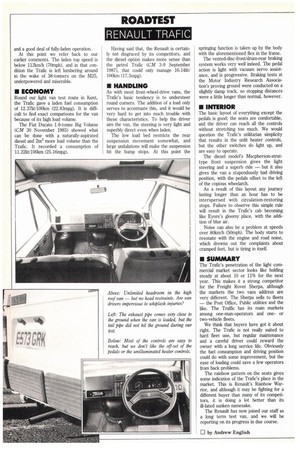ROADTEST RENAULT TRAFIC
Page 94

If you've noticed an error in this article please click here to report it so we can fix it.
and a good deal of fully-laden operation.
At this point we refer back to our earlier comments. The laden top speed is below 112Iun/h (70mph), and in that condition the Trafic is left lumbering around in the wake of 38-tonners on the M25, underpowered and miserable.
• ECONOMY
Round our light van test route in Kent, the Trafic gave a laden fuel consumption of 12.37litJ1001un (22.83mpg). It is difficult to find exact comparisons for the van because of its high load volume.
The Fiat Ducato 1.6-tonne Big Volume (CM 30 November 1985) showed what can be done with a naturally-aspirated diesel and 2rna more load volume than the Trafic. It recorded a consumption of 11.22k/100km (25.16mpg). Having said that, the Renault is certainly not disgraced by its competitors, and the diesel option makes more sense than the petrol Trafic (CM 3-9 September 1987), that could only manage 16.141iti 100Iun (17.5mpg).
• HANDLING
As with most front-wheel-drive vans, the Trafic's basic tendency is to understeer round corners. The addition of a load only serves to accentuate this, and it would be very hard to get into much trouble with these characteristics. To help the driver aim the van, the steering is very light and superbly direct even when laden.
The low load bed restricts the rear suspension movement somewhat, and large undulations will make the suspension hit the bump stops. At this point the springing function is taken up by the body with the aforementioned flex in the frame.
The vented-disc-front/drum-rear braking system works very well indeed. The pedal action is light with vacuum servo assistance, and is progressive. Braking tests at the Motor Industry Research Association's proving ground were conducted on a slightly damp track, so stopping distances were a little longer than normal, however.
• INTERIOR
The basic layout of everything except the pedals is good; the seats are comfortable, and the driver can reach all the controls without stretching too much. We would question the Trafic's utilitarian simplicity that results in the unlit heater controls, but the other switches do light up, and are easy to operate.
The diesel model's Macpherson-struttype front suspension gives the light steering and a superb ride — but it also gives the van a stupendously bad driving position, with the pedals offset to the left of the copious wheelarch.
As a result of this layout any journey lasting longer than an hour has to be interspersed with circulation-restoring stops. Failure to observe this simple rule will result in the Trafic's cab becoming like Eyore's gloomy place, with the addition of blue air.
Noise can also be a problem at speeds over 801unfh (50mph). The body starts to resonate with the engine and road noise, which drowns out the complaints about cramped feet, but is tiring in itself.
• SUMMARY
The Trafic's penetration of the light commercial market sector looks like holding steady at about 10 or 11% for the next year. This makes it a strong competitor for the Freight Rover Sherpa, although the markets the two vans address are very different. The Sherpa sells to fleets — the Post Office, Public utilities and the like. The Traffic has its main markets among one-man-operators and oneor two-vehicle fleets.
We think that buyers have got it about right. The Trafic is not really suited to hard fleet use, but regular maintenance and a careful driver could reward the owner with a long service life. Obviously the fuel consumption and driving position could do with some improvement, but the ease of loading could save a few operators from back problems.
The rainbow pattern on the seats gives some indication of the Trafic's place in the market. This is Renault's Rainbow Warrior, and although it may be fighting for a different buyer than many of its competitors, it is doing a lot better than its ill-fated sunken namesake.
The Renault has now joined our staff as a long term test van, and we will be reporting on its progress in due course.




































































































































